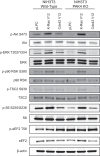Systems-wide analysis of K-Ras, Cdc42, and PAK4 signaling by quantitative phosphoproteomics
- PMID: 23608596
- PMCID: PMC3734570
- DOI: 10.1074/mcp.M112.027052
Systems-wide analysis of K-Ras, Cdc42, and PAK4 signaling by quantitative phosphoproteomics
Abstract
Although K-Ras, Cdc42, and PAK4 signaling are commonly deregulated in cancer, only a few studies have sought to comprehensively examine the spectrum of phosphorylation-mediated signaling downstream of each of these key signaling nodes. In this study, we completed a label-free quantitative analysis of oncogenic K-Ras, activated Cdc42, and PAK4-mediated phosphorylation signaling, and report relative quantitation of 2152 phosphorylated peptides on 1062 proteins. We define the overlap in phosphopeptides regulated by K-Ras, Cdc42, and PAK4, and find that perturbation of these signaling components affects phosphoproteins associated with microtubule depolymerization, cytoskeletal organization, and the cell cycle. These findings provide a resource for future studies to characterize novel targets of oncogenic K-Ras signaling and validate biomarkers of PAK4 inhibition.
Figures





Similar articles
-
CDC42 binds PAK4 via an extended GTPase-effector interface.Proc Natl Acad Sci U S A. 2018 Jan 16;115(3):531-536. doi: 10.1073/pnas.1717437115. Epub 2018 Jan 2. Proc Natl Acad Sci U S A. 2018. PMID: 29295922 Free PMC article.
-
Cdc42- and Rac1-mediated endothelial lumen formation requires Pak2, Pak4 and Par3, and PKC-dependent signaling.J Cell Sci. 2008 Apr 1;121(Pt 7):989-1001. doi: 10.1242/jcs.020693. Epub 2008 Mar 4. J Cell Sci. 2008. PMID: 18319301
-
Compartmentalized Ras proteins transform NIH 3T3 cells with different efficiencies.Mol Cell Biol. 2011 Mar;31(5):983-97. doi: 10.1128/MCB.00137-10. Epub 2010 Dec 28. Mol Cell Biol. 2011. PMID: 21189290 Free PMC article.
-
Regulation of phosphorylation pathways by p21 GTPases. The p21 Ras-related Rho subfamily and its role in phosphorylation signalling pathways.Eur J Biochem. 1996 Dec 1;242(2):171-85. doi: 10.1111/j.1432-1033.1996.0171r.x. Eur J Biochem. 1996. PMID: 8973630 Review.
-
Oncogenic KRas mobility in the membrane and signaling response.Semin Cancer Biol. 2019 Feb;54:109-113. doi: 10.1016/j.semcancer.2018.02.009. Epub 2018 Feb 27. Semin Cancer Biol. 2019. PMID: 29499269 Review.
Cited by
-
Complementary PTM Profiling of Drug Response in Human Gastric Carcinoma by Immunoaffinity and IMAC Methods with Total Proteome Analysis.Proteomes. 2015 Aug 7;3(3):160-183. doi: 10.3390/proteomes3030160. Proteomes. 2015. PMID: 28248267 Free PMC article.
-
Evolution of the highly networked deubiquitinating enzymes USP4, USP15, and USP11.BMC Evol Biol. 2015 Oct 26;15:230. doi: 10.1186/s12862-015-0511-1. BMC Evol Biol. 2015. PMID: 26503449 Free PMC article.
-
Functional genomics identifies negative regulatory nodes controlling phagocyte oxidative burst.Nat Commun. 2015 Jul 21;6:7838. doi: 10.1038/ncomms8838. Nat Commun. 2015. PMID: 26194095 Free PMC article.
-
Reversible phosphorylation of the 26S proteasome.Protein Cell. 2017 Apr;8(4):255-272. doi: 10.1007/s13238-017-0382-x. Epub 2017 Mar 3. Protein Cell. 2017. PMID: 28258412 Free PMC article. Review.
-
A respiratory chain controlled signal transduction cascade in the mitochondrial intermembrane space mediates hydrogen peroxide signaling.Proc Natl Acad Sci U S A. 2015 Oct 20;112(42):E5679-88. doi: 10.1073/pnas.1517932112. Epub 2015 Oct 5. Proc Natl Acad Sci U S A. 2015. PMID: 26438848 Free PMC article.
References
-
- Schubbert S., Shannon K., Bollag G. (2007) Hyperactive Ras in developmental disorders and cancer. Nat. Rev. 7, 295–308 - PubMed
Publication types
MeSH terms
Substances
LinkOut - more resources
Full Text Sources
Other Literature Sources
Molecular Biology Databases
Research Materials
Miscellaneous

